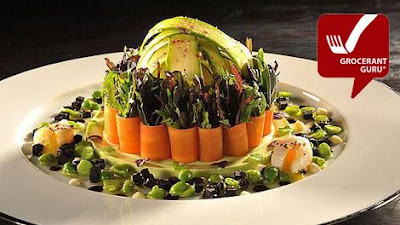Back in the ‘hay-day’
of the chain restaurant industry 1965-1978. CEO’s of the new restaurant brands
were young according to Steven
Johnson, Grocerant Guru® at
Tacoma, WA based Foodservice
Solutions®. Think of Fred Deluca,
John Galardi, Norman Brinker, John Y. Brown, or and our Grocerant Guru®. What was important also was chains the ilk of
KFC, and Pizza Hut, hired right
out of Harvard Business School’s MBA Program’s for their C-suite that were given
senior C-level post to drive sales, growth, innovation then promoted to CEO
quickly.
They hired ‘young-guns’
as outside eyes with the pulse of the consumer top of mind. They did things
different, with a twist and displaces customer habits of eating at home,
dislodged legacy grocery retails grip on the consumer, while elevating their brands
and the restaurant industry. They were
different, they were young, they were not afraid to think outside the box.
Ah, then many their
respective chains got so large they became an institution rather than a
innovator of service, flavor, or footprint.
If you have a CEO that is there to ‘do no harm’, odds are that CEO is
doing very little while collecting a very big pay check.
Steven Johnson, Grocerant
Guru® at Tacoma, WA based Foodservice Solutions®, stated, “if you have a CEO
that is boasting to Wall Street Types about the great job done driving takeout
sales during the pandemic it time to let the CEO go and hire a thirty something
Yale, Cornell, Saint Joseph’s or Harvard MBA.
When a CEO is
bragging about something they were forced to do, that is not leading. Times are chaining faster than the mind of a sixty
something CEO. Here let’s just look at this
one example. It you think this is a nutty idea you should not be a CEO.
Joe Guszkowski wrote the following
article for Restaurant Business Onlineout team thinks it a great read and
should be required reading of all CEO’s today.
“An emerging
chain known for fried chicken served in ice cream cones is selling nonfungible
tokens for $14,500 a pop to help it open more restaurants.
It’s yet another example of how restaurants are wading into the world of NFTs, or one-of-a-kind digital images that can be bought
and sold online. But most of the experiments so far have been focused on
customer engagement rather than actually generating revenue.
Chick’nCone,
on the other hand, hopes to sell more than 900 “Chick’nCoins” for 5.5 Ethereum each, or about
$14,500. Ethereum is a cryptocurrency.
That might seem like a lot to pay for
what amounts to a simple, black-and-white image of the word
“Chick’nCoin.” But the coins
could net a big payout for owners willing to take a risk.
Here’s how that would work. Each of the
933 coins represents a particular region in the U.S. If a person buys a coin,
and Chick’nCone later sells or opens a
restaurant in the region, that person gets $22,500—or half of the restaurant’s
$45,000 franchise fee.
They’re also entitled to 2% of the
restaurant’s sales for six years. And if they get a region that already has
Chick’nCone restaurants, they can start collecting their cut right away.
The coins are doled out randomly, and
there’s a chance Chick’nCone will never sell or open a restaurant in the region
covered by a coin. In that case, Chick’nCone gets $14,500, and you don’t get
anything. (Not even a waffle cone filled with chicken.)
On the other hand, “If we sell one in
your region, then you’ve almost doubled your money,” said Chick’nCone
co-founder and CEO Jonathan Alamanzar.
Buyers can also re-sell their NFT on the
secondary market, though Chick'nCone gets 10% of the sale.
Founded in 2014, the Florida-based chain
currently has 24 restaurants in 12 states, with another 58 under development.
It expects to have a total of 50 open by the end of 2022. And it sees the NFT
revenue as a smart way to fuel its growth.
“What we’re trying to do is raise
capital, basically,” Alamanzar said. “That’s the whole goal behind this:
raising capital without giving away equity in the company.
“If we sell 300 of them, it’s gonna
accelerate our growth tremendously.”
Alamanzar has been interested in NFTs and
cryptocurrency for a while. He was among the first people to buy collectible
NBA highlights known as Top Shots. As he watched their value skyrocket over
time, he began to think about how NFTs could be applied to the restaurant
business, but in a way “that’s actually valuable instead of it being like, ‘Own
this NFT and get 10% off of a chicken sandwich,’” he said.
That’s how he came up with the idea for
Chick’nCoin, which could help the chain grow without making it beholden to
traditional investors or banks.
“I want to do everything we can to get us
as far as we can before we take institutional capital, and maybe never have
to,” he said.
He does expect buyers to be investor
types rather than people involved in NFTs and crypto. An initial launch of 10
Chick’nCoins sold out within a week, and all 10 buyers had little to no
experience in NFTs.
“They just saw it as a good deal,”
Alamanzar said.
An added benefit of selling the coins is
that it would create hundreds of Chick’nCone superfans who will help promote
the chain, not only because they might like the food, but because it could make
them money.
When it came to setting a price for the
coins, the process was fairly unscientific.
“$14,500 feels like an amount that people
would be OK spending,” Alamanzar said.
As for the $22,500 payout, he wanted
coinholders to be able to get a good return while also leaving the company with
enough money to actually open the restaurant it sold.
There are some costs associated with
selling the coins. Chick’nCone has to spend money to create the NFTs through a
process called minting, as well as generate what are known as smart contracts
for each. If it doesn’t sell any coins, it could be in the hole.
But the bigger risk, Alamanzar said, is
that Chick’nCoin could hurt the company’s short-term valuation because it will
be essentially giving away revenue to coinholders.
“If I were planning on selling next week,
then yes, I would be super worried that I was gonna be losing money doing
this,” Alamanzar said. “
Does your chain restaurant organization look
like, run like an organizational institution? Does your brand look more like it
did in 1970, 1980, than brands developing in the virtual world? Where are your consumers buying dinner tonight?
How has had held digital marketing evolve with the consumer? Not sure?
Are
you looking for a new partnership to drive sales? Are you ready for some fresh
ideations? Do your food marketing tactics look more like yesterday that
tomorrow? Visit GrocerantGuru.com for more information
or contact: Steve@FoodserviceSolutions.us Remember success
does leave clues and we just may have the clue you need to propel your
continued success.
In a Battle for Share of Stomach
Does your Brand look more like
Yesterday, Today, or Tomorrow?






No comments:
Post a Comment